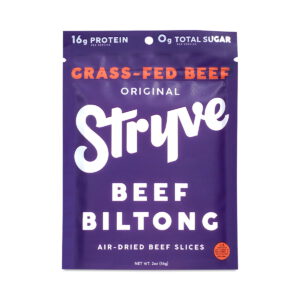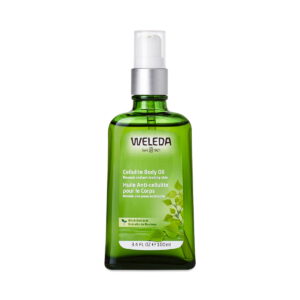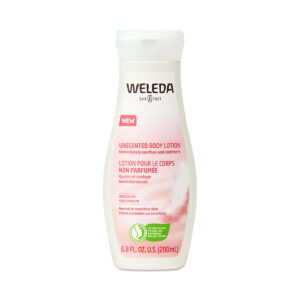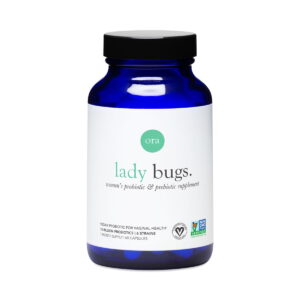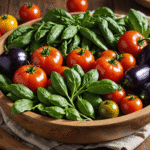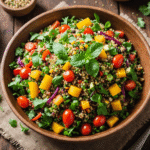- Nutrient-dense options for lasting energy
- High-fiber foods to promote satiety
- Protein-rich snacks to curb cravings
- Healthy fats that keep you satisfied
- Hydrating foods that help control appetite
- Meal planning tips for sustained fullness
When navigating the grocery aisles, it’s essential to prioritize healthy foods that will keep your energy levels steady throughout a busy lifestyle. Start by focusing on whole grains, which are excellent sources of nutrients and energy. Items like quinoa, brown rice, and farro not only provide lasting fuel but also offer a range of vitamins and minerals.
Next, consider the beauty of fruits and vegetables, especially those that are colorful and locally sourced. Purchasing seasonal produce from farmers’ markets not only supports local agriculture but also ensures you’re eating at peak freshness. Think about vibrant options like sweet potatoes, kale, or berries, which are packed with antioxidants and fibers that help you feel full longer.
When it comes to online shopping, aim for trusted organic brands that prioritize safety and sustainability. Be sure to read labels carefully to avoid added sugars and unhealthy preservatives. Look for options with minimal ingredients, and don’t hesitate to reach out to customer service if you have questions about sourcing or product origins.
If you’re a vegan or simply looking to incorporate more plant-based proteins, consider legumes such as chickpeas, lentils, and black beans. These are not only budget-friendly but incredibly versatile, giving you the chance to create hearty dishes that will keep you satiated. Furthermore, nuts and seeds, such as almonds and chia seeds, are excellent sources of healthy fats and can be easily added to your meals or enjoyed as on-the-go snacks.
Pay attention to the safety of ingredients when shopping, especially in bulk or online. Avoid purchasing products with damaged packaging or insufficient labels. Research brands to ascertain their commitment to quality and safety. A few minutes spent researching can save you from unwanted surprises and ensure you’re getting the most out of your choices.
High-fiber foods to promote satiety
High-fiber foods are vital for maintaining fullness throughout the day, particularly in our modern busy lifestyle, where meals often get rushed or skipped entirely. Fiber works in two key ways: it slows digestion and adds bulk to your diet, making you feel fuller for longer. Incorporating high-fiber foods can lead to better weight management and overall health.
Foods rich in soluble fiber help to absorb water and form a gel-like substance in the gut, which further promotes satiety. Examples of such foods include oats, apples, and legumes. On the other hand, insoluble fiber adds bulk to your stool and promotes regular bowel movements and can be found in whole grains, nuts, and vegetables like carrots and celery. Both soluble and insoluble fibers play crucial roles in digestive health and fullness.
To illustrate the variety of high-fiber options, the following table outlines some of the top fiber-rich foods along with their fiber content per serving:
| Food Item | Serving Size | Fiber Content (grams) |
|---|---|---|
| Chia Seeds | 2 tbsp | 10 |
| Black Beans | 1 cup, cooked | 15 |
| Lentils | 1 cup, cooked | 16 |
| Quinoa | 1 cup, cooked | 5 |
| Oats | 1 cup, dry | 8 |
| Broccoli | 1 cup, cooked | 5 |
| Avocado | 1 medium | 10 |
| Raspberries | 1 cup | 8 |
Integrating these high-fiber foods into meals can also enhance the overall nutritional profile of your diet. For example, adding lentils to salads or soups not only increases fiber intake but also adds plant-based protein. Oats can be transformed into overnight oats with the addition of fruits and nuts, creating a convenient and filling breakfast option.
Snacking on fiber-rich foods like air-popped popcorn or whole grain crackers can keep cravings at bay throughout a hectic day. By choosing healthy, high-fiber options, you can ensure that your body remains satisfied and your energy levels stay stable, effectively supporting your busy lifestyle.
Protein-rich snacks to curb cravings
- Nutrient-dense options for lasting energy
- High-fiber foods to promote satiety
- Protein-rich snacks to curb cravings
- Healthy fats that keep you satisfied
- Hydrating foods that help control appetite
- Meal planning tips for sustained fullness
In the hustle and bustle of a busy lifestyle, keeping protein-rich snacks on hand is essential for curbing cravings and staving off hunger between meals. Whether you’re a fitness enthusiast needing to fuel up post-workout or a professional seeking healthy foods to maintain focus during long hours, snacks high in protein can be your best ally.
When shopping for protein-packed options, start with nuts and seeds. Almonds, walnuts, and pumpkin seeds are not only nutrient-dense but also portable, making them perfect for on-the-go snacking. For instance, a small handful of almonds can provide about 6 grams of protein. Consider mixing them with dried fruit for a sweet and savory trail mix that’s rich in fiber, keeping you satisfied even longer.
Another fantastic option is cottage cheese or Greek yogurt. These dairy products can be found in most grocery stores and are packed with protein. They can be enjoyed plain or topped with fruits, honey, or a sprinkle of chia seeds for an added fiber boost. For those with a vegan lifestyle, reach for plant-based yogurts made from almond or soy milk, but be sure to check for added sugars and ensure they contain adequate protein content.
Legumes such as chickpeas and lentils are not just for main meals; they also make great snacks. Roasted chickpeas can be seasoned and enjoyed as a crunchy alternative to chips, offering about 7 grams of protein per serving. Additionally, offer your family easy-to-prep options like lentil salad or lentil hummus for a protein-rich dip that’s both filling and nutritious.
Hard-boiled eggs are another protein powerhouse, providing nearly 6 grams of protein each. They can be prepared in advance and stored in the refrigerator for quick, healthy snacks that are also very satisfying. Finally, consider lean meats such as turkey or chicken breast slices; whether rolled in a wrap with veggies or simply on their own, they’re an excellent way to keep your protein levels high while enjoying a tasty treat.
For those who love online shopping, look for stores that specialize in bulk and organic products. This can save money while ensuring you’re getting high-quality snacks. Many brands now offer individual packaging for convenience, but if you’re purchasing in bulk, ensure the packing is intact and free of any contamination.
Lastly, focus on the safety of your ingredients when buying protein-rich snacks. Always check expiration dates, and if you’re buying online, seek out retailers with secure payment methods and transparent product sourcing. By making informed choices in protein snacking, you create a solid foundation for managing your appetite, keeping you full, and supporting your overall health throughout the day.
Healthy fats that keep you satisfied
Incorporating healthy fats into your daily meals is essential for maintaining satisfaction and energy levels throughout your busy lifestyle. Unlike refined carbohydrates, which can lead to quick spikes and drops in energy, fats provide a slow and steady release of energy. This helps you stay full longer and supports overall satiety.
Avocados are a prime example of a healthy fat source. They are rich in monounsaturated fats, which are known to reduce bad cholesterol levels and promote heart health. Additionally, avocados contain fiber, adding another layer of fullness to your diet. You can enjoy them sliced on toast, blended into smoothies, or mashed into guacamole for a delicious dip.
Nuts and seeds are also excellent sources of healthy fats. Almonds, walnuts, chia seeds, and flaxseeds not only provide essential fatty acids but also offer protein, fiber, and a variety of vitamins and minerals. A small handful of mixed nuts can be an extremely satisfying snack, providing a balance of nutrients that help control appetite. For added convenience, consider making your own nut butter and pairing it with apple slices or spreading it on whole-grain crackers for a filling snack.
Olive oil, another heart-healthy fat, can easily be integrated into your meals. Drizzling it over salads, using it as a base for dressings, or employing it in cooking adds flavor and enhances the absorption of fat-soluble vitamins from your meals. The richness of olive oil not only elevates the taste but also contributes to a sense of fullness.
Fatty fish such as salmon, mackerel, and sardines are great choices as well. They are packed with omega-3 fatty acids, which are beneficial for brain health and can help reduce inflammation in the body. Including these fish in your weekly meal plan provides both healthy fats and high-quality protein, keeping you satisfied longer after eating.
Don’t overlook the potential of dark chocolate with a high cocoa percentage. A small piece can provide a luxurious experience and curb sweet cravings while still offering healthy fats. It’s important to choose varieties that have low sugar content to maximize health benefits.
Incorporating healthy fats into your diet doesn’t have to be complicated. Meal prepping can help you manage portions and ensure you have satisfying and nutritious meals ready to go during your busy days. Consider preparing salads with a variety of nuts and seeds or making energy bites with oats, nut butter, and dark chocolate for easy snacking options.
“Healthy fats are not the enemy; they are essential for keeping you satisfied and fueling your life!”
Opting for wholesome fats will enhance your diet, make meals more enjoyable, and contribute significantly to feelings of fullness throughout the day.
Hydrating foods that help control appetite
Incorporating hydrating foods into your daily diet is a smart strategy for controlling appetite and staying full, especially during busy days when it might be easy to overlook your hydration needs. Foods such as cucumbers, watermelon, oranges, and celery are not only high in water content but also packed with vitamins, minerals, and fibers that contribute to overall health and satiety. By incorporating these options into your meals or snacks, you can effectively curb hunger and promote a sense of fullness.
Cucumbers, for instance, consist of about 95% water, making them an excellent choice for hydration. Chopped cucumbers can be added to salads or enjoyed as a refreshing snack with hummus or a yogurt dip. Similarly, watermelon is another hydrating fruit that, with its sweetness, provides not only hydration but also vitamins A and C, making it a delicious choice on a hot day.
Oranges and other citrus fruits are not only hydrating but also provide a significant amount of fiber and vitamin C, which can help boost your immune system. Snacking on orange segments can satisfy your sweet tooth while keeping you hydrated and feeling satisfied. It’s also worth noting that most fruits can effectively delay the urge to snack on less healthy options, promoting a more conscious approach to eating.
Additionally, broth-based soups are an excellent way to incorporate hydration into your diet. A warm bowl of vegetable or chicken soup can fill you up while supplying essential nutrients. By choosing homemade options, you control the quality of ingredients and can ensure that the soups are rich in vegetables and low in sodium.
Another hydrating option to consider is smoothies, which can be a perfect on-the-go meal. Combine fruits, vegetables, and a liquid base like coconut water or almond milk to create a filling drink that provides a balance of hydration, nutrients, and energy to fuel your busy lifestyle.
In the realm of grocery shopping, prioritize fresh fruits and vegetables, and consider exploring sections that offer pre-cut or ready-to-eat options. These not only save time but can also help you consistently add hydrating foods to your snacks and meals. Always be mindful of selecting seasonal produce, as this not only ensures better taste but often increases nutritional benefits.
Maintaining hydration levels with the help of hydrating foods is vital for a balanced approach to eating that supports your health goals while enabling you to navigate your busy lifestyle with energy and satisfaction.
- What are hydrating foods?
- Hydrating foods are those that have a high water content and contribute to your overall hydration. Examples include fruits like watermelon and oranges, and vegetables like cucumbers and lettuce.
- How do hydrating foods help control appetite?
- Hydrating foods are generally low in calories but high in volume, which can help fill your stomach and curb hunger. By consuming these foods, you may feel satisfied with fewer calories overall.
- Can I get enough hydration from foods alone?
- While hydrating foods contribute significantly to hydration, it’s important to also drink water and other fluids throughout the day. A balanced approach combining both is best for maintaining optimal hydration levels.
- What are some good hydrating snacks?
- Good hydrating snacks include sliced cucumbers, cherry tomatoes, watermelon cubes, and yogurt-based dips with veggies. These options are not only refreshing but also packed with nutrients.
- Are fruit smoothies considered hydrating?
- Yes, fruit smoothies can be very hydrating, especially when made with a liquid base like coconut water, almond milk, or fruit juice. They blend hydration with nutrients, making them a great snack or meal option.
- How can I include more hydrating foods in my diet?
- To include more hydrating foods, aim to add fruits and vegetables to every meal and snack. Consider creating a salad, a refreshing smoothie, or enjoying whole fruits as snacks throughout the day.
- Do hydrating foods provide significant nutritional benefits?
- Yes, many hydrating foods are not only high in water content but also rich in essential vitamins, minerals, and antioxidants, which contribute to overall health while helping to control appetite.
Meal planning tips for sustained fullness
When it comes to meal planning, having a strategy in place can significantly enhance your ability to stay full and satisfied throughout your busy lifestyle. Start by dedicating some time each week to plan your meals and create a shopping list. This not only helps streamline your grocery shopping but also minimizes impulse purchases that often lead to unhealthy choices.
Begin by selecting a variety of healthy foods that encompass all food groups. Prioritize whole grains, lean proteins, and an assortment of colorful fruits and vegetables. For example, craft your meals around staples like quinoa, brown rice, and sweet potatoes for complex carbohydrates that will provide sustained energy. Pair these with protein sources such as beans, lentils, tofu, or chicken to create well-rounded dishes. Pre-plan meals like stir-fries or hearty salads, ensuring they include healthy fats from nuts or avocados to keep you satisfied longer.
As you draft your meal plan, consider batch cooking. Preparing large quantities of meals in advance allows you to portion them out for quick access when time becomes scarce. For instance, cooking a big pot of chili not only provides multiple meals but also freezes well for later use. This strategy greatly assists in maintaining control over your diet and encourages you to eat home-cooked, nutritious meals rather than resorting to takeout or processed foods.
It’s also essential to think about incorporating snacks into your daily routine. Having healthy, satisfying snacks on hand can prevent the temptation of less nutritious options. Snack on high-fiber foods like cut-up veggies with hummus, or grab a small handful of nuts for a protein-packed boost. Pre-portioning these snacks into grab-and-go containers can keep your cravings in check and ensure you’re nourishing your body with the right foods.
Utilizing grocery delivery services can save you time and help enforce the habit of careful shopping. Many services allow you to choose organic options and even provide recommendations based on your dietary preferences. Make sure to check the reviews on the quality of products and the delivery process. Always look for platforms that emphasize food safety, such as offering temperature-controlled delivery for perishables.
In terms of ingredient safety, when shopping, focus on whole, unprocessed foods as much as possible. Avoid items that have long ingredient lists filled with additives and preservatives. Fresh produce and minimally processed products should be your go-to. Don’t hesitate to ask questions about sourcing and preparation if you’re purchasing from local farms or farmer’s markets; transparency is key to ensuring you’re getting quality ingredients.
Lastly, keep your grocery budget in check by comparing prices of local versus organic products. Consider joining a local co-op or community-supported agriculture (CSA) program, which often offers organic produce at lower prices while supporting local farmers. This approach also motivates you to eat with the seasons, ensuring that you consume the freshest and most nutrient-dense options available.
By employing these meal planning tips, you can foster a healthier relationship with food while ensuring that your meals support your lifestyle, keep you full, and empower you to meet the demands of your day-to-day activities with energy and vitality.
New Customers Offer!
Free Gift for the new customer
$24 Value, When You Subscrib Visit Thrive Market
